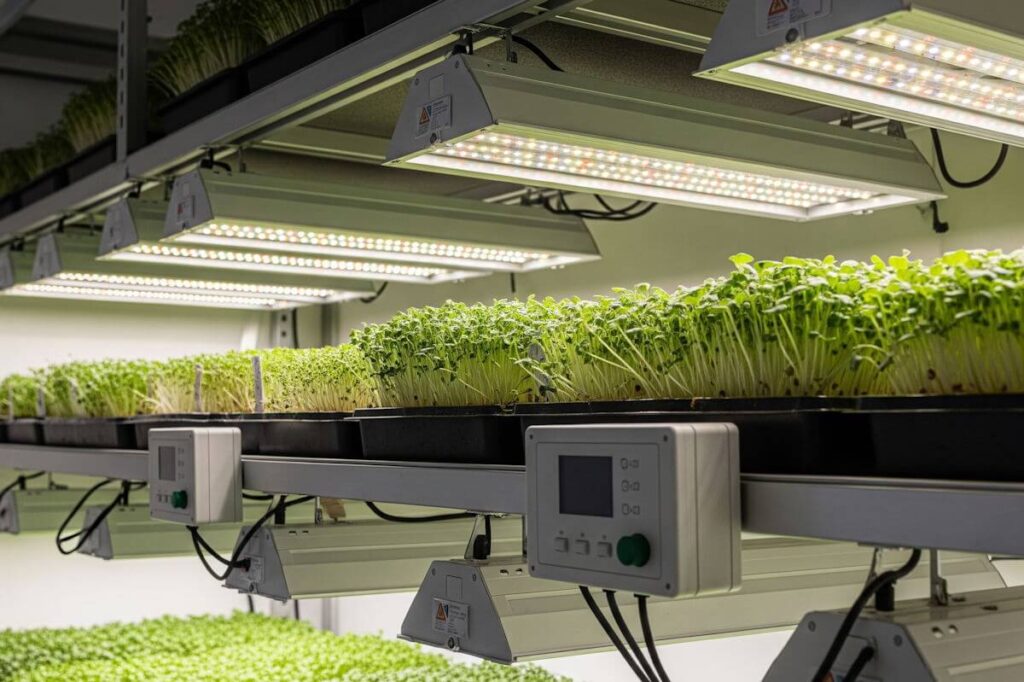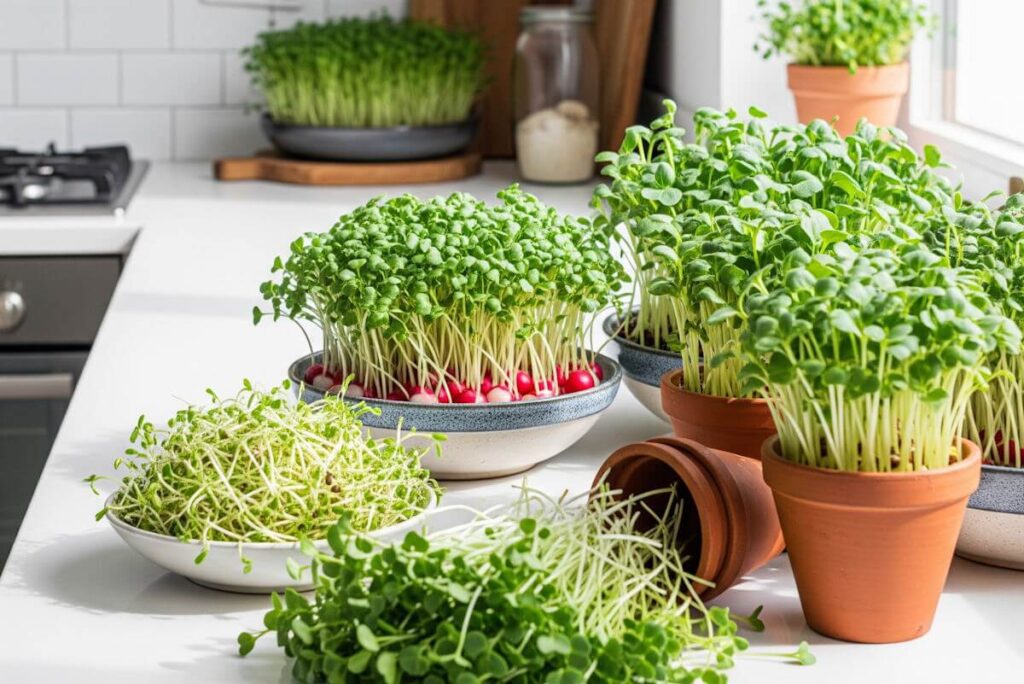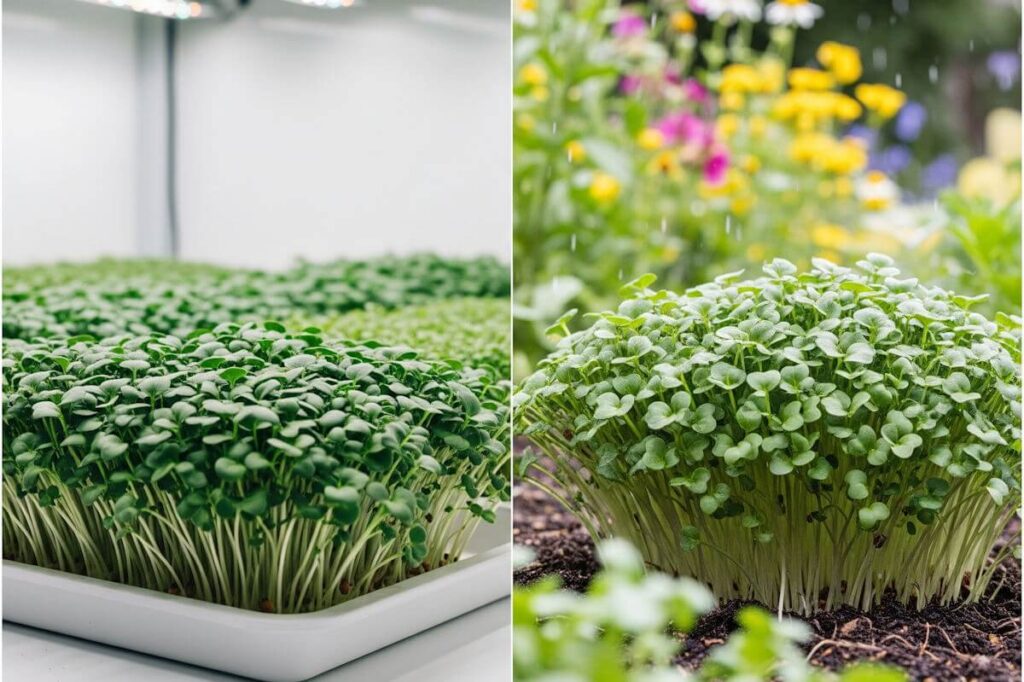Introduction to Indoor Microgreens
Microgreens are young, edible plants harvested at an early stage of growth, typically between seven to twenty-one days after germination. They are characterized by their vibrant colors and intense flavors, making them an attractive addition to a variety of culinary dishes. This trend has gained considerable traction among health-conscious individuals and culinary enthusiasts alike, who appreciate the concentrated nutrient profile that microgreens offer. They are rich in vitamins, minerals, and antioxidants, contributing to a well-rounded diet. For instance, varieties like radish and broccoli microgreens provide substantial levels of vitamin C, while others like sunflower microgreens are noted for their high vitamin E content.
The practice of growing microgreens indoors has surged in popularity due to several factors. First, it allows for year-round cultivation, independent of outdoor seasonal constraints. Furthermore, indoor gardening eliminates many pests and diseases commonly associated with outdoor gardening, making it a more manageable option for urban dwellers. The convenience of growing microgreens indoors makes them accessible to a broader audience, including those with limited space or gardening experience.
As the popularity of indoor microgreens grows, so does the emphasis on optimizing growth conditions, particularly lighting. Proper lighting is vital for the photosynthesis process, enabling microgreens to produce the nutrients required for healthy development. Without adequate light, these young plants may become leggy, pale, and less flavorful, ultimately compromising their nutritional benefits. Therefore, understanding the best lighting setup is essential for anyone interested in cultivating microgreens indoors. This guide will detail the various aspects of lighting that contribute to successful indoor microgreen gardening.
Understanding Plant Light Requirements
Lighting is an essential component for the successful growth and development of indoor microgreens. Understanding the specific light requirements of these plants helps growers maximize yield and quality. One of the foundational aspects of plant light requirements is the concept of photosynthetically active radiation (PAR), which encompasses the spectrum of light wavelengths that plants utilize for photosynthesis, typically ranging from 400 to 700 nanometers.
Different wavelengths within this spectrum play varying roles in plant growth. For instance, blue light (around 400-500 nm) is instrumental during the vegetative stage, promoting leaf growth and developing a robust structure. In contrast, red light (600-700 nm) encourages flowering and seed production. A balanced combination of these wavelengths is vital for cultivating healthy microgreens, as it ensures that the plants receive a well-rounded spectrum that supports all stages of their life cycle.
Moreover, light intensity is another critical factor to consider. Microgreens typically thrive under relatively high light intensity; however, too much light can lead to stress and inhibit growth. Ideally, the light intensity should range between 400 to 1,000 µmol/m²/s, depending on the specific microgreen species and growth stage. Furthermore, the duration of light exposure plays a significant role. Most microgreens require about 12-16 hours of light per day to achieve optimal growth. This daily light exposure can be easily managed with timers or grow light systems that allow for adjustable schedules.
Lastly, the quality of light is paramount, which includes both spectral composition and uniformity. Using grow lights that replicate sunlight helps ensure that microgreens receive the necessary wavelengths for robust growth. In conclusion, understanding these fundamental aspects of plant light requirements will enable growers to create an effective lighting setup that promotes healthy indoor microgreens. As a result, attention to light intensity, duration, and quality is essential for fostering optimal growth conditions in an indoor environment.
Types of Grow Lights and Their Benefits
Lighting is a critical component in the successful growth of indoor microgreens. Various types of grow lights are available, each with distinct advantages and disadvantages. Understanding these types can greatly enhance the indoor gardening experience.
LED grow lights have gained popularity due to their energy efficiency and longevity. These lights produce a spectrum ideal for plant growth without emitting excessive heat, minimizing the risk of damaging delicate seedlings. Additionally, LED lights are available in mixed spectrum options, which can cater to different plant species’ light needs. However, the initial investment can be higher compared to other lighting options.
Fluorescent lights, particularly T5 and T8 variants, are another excellent choice for growing microgreens. They are relatively inexpensive and produce a sufficient light spectrum for the growth phase of young plants. Fluorescent lights are also well-suited for a close growing environment, as they emit less heat, allowing them to be positioned closer to the plants without risk. On the downside, these lights typically have a shorter lifespan than LED options and may require more frequent replacements.
High-Intensity Discharge (HID) lights, including Metal Halide (MH) and High-Pressure Sodium (HPS) lamps, are often used in larger indoor gardening setups. HID lights provide intense illumination and are highly effective for a range of vegetables and herbs, including microgreens. However, they consume more electricity and produce significant heat, necessitating careful management of temperature and ventilation in the growing area.
In summary, while LED lights offer long-lasting benefits and efficient energy use, fluorescent lights are affordable and effective for smaller settings. HID lights are suitable for more extensive operations, but they demand more careful management. Selecting the optimal grow light for indoor microgreens depends on individual gardening goals, available space, and budget considerations.
Optimal Light Spectrum for Microgreens
Microgreens, renowned for their vibrant flavors and nutritional value, thrive under specific light conditions that significantly influence their growth rates and qualities. Among the various spectrums of light, blue and red wavelengths play essential roles in the photosynthesis process, which is critical for the healthy development of these young plants. Understanding the optimal light spectrum for microgreens can pave the way for successful indoor cultivation.
Blue light, typically ranging from 400 to 500 nanometers, is vital during the vegetative growth stage of microgreens. This spectrum promotes robust leaf development and encourages compact growth. When blue light is included in the lighting setup, microgreens tend to exhibit a bushier form, which results in a higher yield per square foot. Additionally, blue light can also enhance the chlorophyll production in microgreens, further facilitating efficient photosynthesis and thus accelerating growth rates.
Conversely, red light, which generally falls between 600 to 700 nanometers, is particularly instrumental in the flowering and fruiting stages of plant life. When applied to microgreens, red light can contribute to the synthesis of essential oils and other flavor compounds, potentially affecting the taste and quality of the final product. An optimal balance of red light can also assist in overall plant health, aiding various physiological processes.
It is critical for growers to consider a full-spectrum lighting system that combines both blue and red light, as each plays a unique role in the growth of microgreens. Many grow lights are readily available today that mimic the natural sunlight spectrum, providing the necessary illumination for indoor cultivation. By ensuring that microgreens receive these essential light wavelengths, cultivators can optimize growth, enhance flavor profiles, and produce healthier plants overall.
Determining the Right Light Intensity
When cultivating indoor microgreens, understanding the appropriate light intensity is crucial for their growth and development. Microgreens are young plants harvested shortly after their first true leaves emerge, and the light requirements can vary significantly based on the species and growth stage. Typically, microgreens thrive under light intensities ranging from 200 to 800 µmol/m²/s, but these values may differ depending on specific plant requirements.
Initially, during the first week of growth, most microgreens require lower light levels, around 200 to 400 µmol/m²/s, as they are still establishing their root systems and foliage. As they mature, especially post the first week, plants can benefit from increased intensity, peaking around 600 to 800 µmol/m²/s for optimal growth. This transition is essential for preventing leggy growth and promoting robust, healthy plants.
Utilizing a light meter is an effective way to measure the light intensity accurately. A quantum light meter, which specifically measures the photosynthetically active radiation (PAR), is ideal for this purpose. By placing the sensor at the same height as the microgreens, growers can obtain precise readings that will help in adjusting the distance of the light source as well as its settings. For instance, if the light intensity is too low, increasing the height of LED fixtures or using more powerful bulbs could enhance growth. Conversely, if readings exceed the desired range, raising the lights or reducing their output can mitigate potential light stress on the plants.
In conclusion, determining the right light intensity is integral to cultivating healthy microgreens. By considering the growth stage and utilizing appropriate measurement tools, growers can provide their plants with the optimal environment necessary for thriving indoor cultivation.
Best Lighting Duration for Microgreens
When cultivating microgreens, understanding the optimal lighting duration is essential for maximizing growth and quality. Microgreens require adequate light to photosynthesize, which in turn supports robust growth and healthy development. The ideal lighting duration generally hinges on two critical factors: day length and photoperiod.
Most microgreens thrive under a photoperiod of 12 to 16 hours of light per day. This duration mimics their natural environment and promotes vigorous growth. Species such as basil, cilantro, and radish typically respond positively to this schedule, exhibiting minimal stress and robust growth. On the other hand, microgreens like kale and arugula can be sufficiently grown under a slightly shorter lighting period—around 10 to 12 hours each day—demonstrating their versatility in low-light conditions.
It’s crucial to maintain consistency in your light schedule to avoid common issues such as stretching, where plants grow leggy due to insufficient light, or burnout, where they become stressed from excessive exposure to bright light. To achieve this balance, consider utilizing a timer for your grow lights. Establishing a fixed routine will contribute to the stability needed for optimal growth, ensuring that your microgreens receive the appropriate light while minimizing the risk of mishaps.
Additionally, gradual adjustments to the light cycle can be beneficial. For example, if transitioning microgreens from a lower light environment to a higher one, incrementally increasing light exposure over several days can help prevent shock and encourage adaptation to the new conditions. Observing the plants regularly will assist you in fine-tuning the lighting duration to suit their developing needs effectively.
Setting Up Your Grow Light System
Establishing an effective grow light system is foundational for cultivating healthy indoor microgreens. To begin, select a suitable grow light type. LED lights are popular due to their energy efficiency and low heat output, while fluorescent lights are effective for nurturing seedlings. Once you have your lights, positioning is crucial. Aim to place the lights about 6 to 12 inches above the microgreens. This distance allows the plants to absorb adequate light without suffering from excess heat, which could impede their growth.
Next, consider the duration of light exposure. Indoor microgreens typically require around 12 to 16 hours of light daily. Utilizing a timer can streamline this process, ensuring your plants receive consistent illumination while eliminating the need for manual adjustments. Daylight bulbs with a color temperature of 6000K to 6500K are optimal, as they mimic natural sunlight, promoting robust photosynthesis.
As your microgreens begin to grow, it is essential to monitor their progress and adjust the setup accordingly. The plants should be kept an eye on; if they begin to stretch toward the light source, they may be seeking more illumination. In this case, lowering the lights can help promote more compact and healthier growth. Conversely, if the leaves start to curl or turn yellow, it may indicate that the lights are too close or too intense. Adjusting the height accordingly can alleviate this issue.
In summary, setting up a grow light system involves careful consideration of light type, positioning, duration of exposure, and regular adjustments as your microgreens mature. A well-configured lighting environment not only enhances the growth of your indoor microgreens but also ensures that the plants thrive throughout their growing cycle.
Common Mistakes to Avoid
Indoor microgreens cultivation demands a careful approach to lighting, and several common mistakes can hinder growth and yield. One prevalent mistake is providing insufficient light duration. Microgreens usually require around 12 to 16 hours of light per day to thrive. Many beginners either underestimate this requirement or fail to maintain a consistent light cycle. To prevent this, investing in a reliable timer can help automate the lighting schedule, ensuring that microgreens receive the optimal amount of light daily.
Another frequent error involves incorrect intensity settings. Different types of microgreens may have varying light requirements, and using lights that are too dim can impede growth. Conversely, excessive intensity might lead to burnt seedlings. To find the right balance, indoor gardeners should familiarize themselves with the specific light needs of the varieties they are growing and adjust the wattage or height of their grow lights accordingly. This may involve moving the lights closer or further away, based on the feedback from the plants.
Poor light positioning also contributes to suboptimal growth. Placing the light sources too far from the plants can result in uneven growth, while direct proximity may cause heat stress. It is essential to ensure that lights are evenly spaced and positioned at an appropriate distance to facilitate uniform exposure to all seedlings. An effective practice is to rotate the microgreens periodically, playing an active role in enhancing their growth patterns.
By identifying these common pitfalls and implementing practical solutions, indoor microgreen gardeners can create a more conducive environment for their plants. Learning and adapting these lighting principles will ultimately lead to healthier growth and a more successful indoor growing experience.
Conclusion and Final Tips
In summary, the significance of adequate lighting in the cultivation of indoor microgreens cannot be overstated. Effective lighting not only facilitates the photosynthesis process but also promotes healthy growth, resulting in vibrant, nutrient-rich microgreens. As we have explored throughout this article, various light sources and setups can be utilized to cater to the specific growth requirements of different microgreen varieties. Whether you choose LED grow lights, fluorescent tubes, or natural sunlight, each option has its distinct advantages and can be optimized to enhance your indoor gardening experience.
As you embark on your journey of growing microgreens indoors, take the time to experiment with different lighting configurations. Changing the position, intensity, and duration of your light source can lead to remarkable differences in plant growth. It is crucial to monitor your microgreens closely and adjust your setup based on their responses to lighting. This hands-on approach not only fosters a deeper understanding of your plants’ needs but can also be an enjoyable aspect of the cultivation process.
Additionally, keep in mind that every indoor growing environment is unique. Factors such as space, type of microgreens, and personal preferences will influence your lighting decisions. Therefore, be open to adapting your strategies based on what works best for you. Remember that the joy of cultivating your own microgreens extends beyond the final product; it is a rewarding experience that allows you to connect with nature and explore your creativity.
Ultimately, ensuring your microgreens receive the right amount of lighting will play a vital role in achieving thriving growth. Embrace the experimentative nature of indoor gardening, and relish the satisfaction of nurturing your own plants from seed to harvest.




